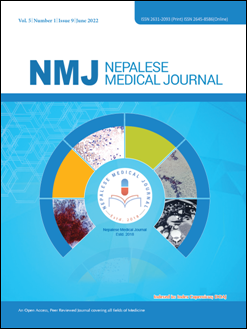Comparative Study of Clinical Profile and Outcome Among Variceal and Nonvariceal Bleeding in a Tertiary Referral Hospital of Nepal During Covid Pandemic
DOI:
https://doi.org/10.3126/nmj.v5i1.44527Keywords:
Non variceal, Upper GI bleeding, VaricealAbstract
Introduction: Upper Gastrointestinal Bleeding is a common medical emergency that is broadly classified into variceal and non-variceal bleeding. Preendoscopicemperical treatment is based on clinical findings and laboratory parameters. The article aimed to compare these parameters among variceal and non-variceal bleeding.
Materials and Methods: This is a retrospective descriptive study conducted in a tertiary level referral hospital after taking approval from the Institutional review board. The data included was from September 2020 to August 2021. All patients with relevant data who underwent upper GI endoscopy were enrolled. The clinical and laboratory parameters were compared using appropriate statistical tests.
Results: A total of 85 patients were studied with 40 (47.06%) in the variceal and 45 (52/94%) in the non-variceal group. Significantly more patients in the variceal bleeding group had a history of alcohol consumption (85% vs 60%) and smoking history (52.50 % vs 31.10%) compared to the non-variceal group. Jaundice, ascites, splenomegaly, low platelet count, and high INR all were predictors of variceal bleeding (p<0.005). In the variceal group, 39 (97.5%) needed endo therapy compared to only 4 (8.9%) in the non-variceal group.
Conclusions: Clinical and laboratory parameters differ significantly in the variceal and non-variceal groups which can guide the pre-endoscopic management of the patients.
Downloads
Downloads
Published
How to Cite
Issue
Section
License
Copyright (c) 2022 Binod Karki, Tshering Wangdi Sherpa, Rajeeb Kumar Deo , Egesh Aryal, Binit Upadhyaya Regmi, Alisha Adhikari, Srijana Katawal, Sujit Kumar Mandal

This work is licensed under a Creative Commons Attribution 4.0 International License.
This license enables reusers to distribute, remix, adapt, and build upon the material in any medium or format, so long as attribution is given to the creator. The license allows for commercial use.
Copyright on any article published by Nepalese Medical Journal is retained by the author(s).
Authors grant Nepalese Medical Journal a license to publish the article and identify itself as the original publisher.
Authors also grant any third party the right to use the article freely as long as its integrity is maintained and its original authors, citation details and publisher are identified.




